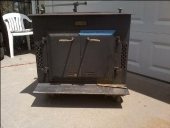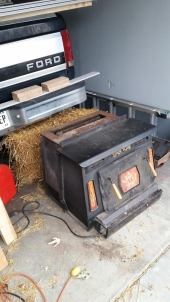
 1
1




Lawrence Wood wrote: With an RMH you have a mass of heated material that slowly radiates the heat into the space in a much more localized manner. I don't doubt that you can blow a fan across it to move the air around and heat things more uniformly. If you are one who likes a uniform heat throughout your house I doubt an RMH would fit your desires. if however you can adapt to having heat in one or two localized places then this is a potentially a good option.
 5
5












 3
3




 1
1




Pastured pork and beef on Vashon Island, WA.




“The most important decision we make is whether we believe we live in a friendly or hostile universe.”― Albert Einstein




 1
1




John Weiland wrote:
My guess would be that most would want to burn material as close to being produced on their own property and as sustainably as possible.
Pastured pork and beef on Vashon Island, WA.




Glenn Herbert wrote:I think waxed cardboard, if not recyclable, is a fine idea for a fuel; however, I would not want to use it as the principal fuel for a RMH, as the firebox is not large enough to fit an amount that would burn for more than a few minutes. I find that crumpled cardboard, egg cartons in particular, makes an excellent starter for my RMH. I put a handful of finely split sticks on top of it, drop in a burning twist of paper, and have a roaring fire in seconds.
Pastured pork and beef on Vashon Island, WA.
 1
1




R Ranson wrote:Which will be best for cooking? Because I want to cook on my woodstove. I am considering getting an iron wood fired cooker for my main cooking and RMH for my main heating.
"Where will you drive your own picket stake? Where will you choose to make your stand? Give me a threshold, a specific point at which you will finally stop running, at which you will finally fight back." (Derrick Jensen)





 2
2




Glenn Herbert wrote:It's hardly a new discovery, but it is a relevant observation. I think the reason that insulating firebricks are not more widely used in RMHs is that they are less common than hard firebrick, usually have to be special ordered if you can find a place that will sell them, and cost about twice as much as hard firebrick. Also, being soft, they are not durable enough to use as the hot face in the parts of the feed tube and burn tunnel that are subject to abrasion or impact.
 1
1




"Where will you drive your own picket stake? Where will you choose to make your stand? Give me a threshold, a specific point at which you will finally stop running, at which you will finally fight back." (Derrick Jensen)
 1
1








Matt Walker wrote:Folks always speculate on durability, but very few have tried it. Most rely on what they "know to be true" from reading, not experience. My point of view on durability vs. performance is that I truly care about efficiency and my neighbors and my footprint, so I choose to have a unit that requires simple, regular maintenance and burns more efficiently than anything else I can afford.
"Where will you drive your own picket stake? Where will you choose to make your stand? Give me a threshold, a specific point at which you will finally stop running, at which you will finally fight back." (Derrick Jensen)








"Where will you drive your own picket stake? Where will you choose to make your stand? Give me a threshold, a specific point at which you will finally stop running, at which you will finally fight back." (Derrick Jensen)





 I think even having the top bricks at the feed tube mouth as hard brick would prevent most abrasion.
I think even having the top bricks at the feed tube mouth as hard brick would prevent most abrasion.
 3
3













Matt Walker wrote:
Glenn, you could experience 30% more efficiency with insulated fire brick in my opinion. I accept that some will choose dirty durable stoves, but I believe it is important to share that we have a choice. Insulated builds are the way forward if we want to improve things for our neighbors and ourselves.












Jessica Johnson wrote:I would like some hard numbers on what the average emissions are for RMHs versus wood stoves that have been built to the EPA's current standards. The closest I've seen so far has been "This Youtube video shows little visible smoke."
 1
1












paul wheaton wrote:
Jessica Johnson wrote:I would like some hard numbers on what the average emissions are for RMHs versus wood stoves that have been built to the EPA's current standards. The closest I've seen so far has been "This Youtube video shows little visible smoke."
For those of us that are keen on rocket mass heaters, you start with how you are heating your home with one tenth the wood. Right off the bat, that suggests that there will be one tenth the emissions.
Next is that when we are in the middle of a burn, the emissions are so clear and virtually odorless. This suggests that during the burn, we are burning cleaner.
So it seems that when comparing to "wood stoves that have been built to the EPA's current standards", a rocket mass heater has, at worst, one tenth of the emissions. Probably much better. Therefore, it is worthwhile to proceed.
Naturally, it seems that if the government is going to throw around billions on energy stuff, it makes sense for them to do some serious number crunching in this space. In the meantime, I think the difference is so profoundly positive, quite a few people are thinking "good enough for me!"
Community Building 2.0: ask me about drL, the rotational-mob-grazing format for human interactions.




 1
1




Silence is Golden
For all your RMH needs:
dragontechrmh.com




Gerry Parent wrote:Hi Kees, Not sure if I've ever come across "ultrafine particles" as being a category of any burn cleanliness tests. Any wood burning appliance is going to produce fly ash and particles coming out the chimney which I think is mostly the elements in wood (minerals) that just can't be broken down any further. So unless your standing close to a chimney pipe and breathing in the exhaust on a continuous basis, I don't think there is any huge risk for most healthy people to be concerned with.





|
That is so lame! You now get a slap from this tiny ad!
The new gardening playing cards kickstarter is now live!
https://www.kickstarter.com/projects/paulwheaton/garden-cards
|








